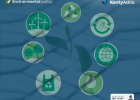Innovation and sustainability currently take center stage in the textile industry
Those who wish to remain competitive in this creative but challenging world, characterized by sudden changes and high consumer demands, must be flexible and ready to provide quick and appropriate responses. The main challenges of the industry are complex but provide opportunities for global growth and development. Two major groups of challenges stand out, playing significant roles in the textile scene.
1. Environmental challenges
The problems the textile industry has always faced include high water consumption, chemical pollution, and waste. Textile dyeing is one such example, and to address this, some of the methods being used are: waterless dyeing using carbon dioxide instead of water, the use of innovative dyeing technologies that reduce energy consumption, and water recycling with the help of specialized machines that reduce both water and energy consumption. Additionally, mechanical and chemical methods of textile recycling are important for achieving the ideal of a green planet. Mechanical recycling is the most common method for recovering post-consumer textile waste. Using techniques such as cutting, crushing, combing, and other mechanical methods, the fabric is separated into fibers during the mechanical recycling process. Chemical recycling is an additional technique for utilizing recovered textile waste.
2. Introduction of innovations – enhancing sustainability and efficiency
The automation of production processes in the textile industry encompasses the adoption of various innovations, some of which include the use of blockchain technology and AI systems. Sophisticated cutting systems use AI to optimize fabric consumption, reducing waste and production costs. These machines can simultaneously cut multiple layers of fabric, significantly improving productivity and shortening the time required for manual cutting. Artificial intelligence and machine learning optimize demand forecasting, reducing overproduction and minimizing waste. The application of blockchain technology enables transparency in the supply chain, providing consumers with information about the origin and production methods of products, which increases trust and accountability within the supply chain. This ensures that all stakeholders, from suppliers to consumers, have access to reliable and trustworthy information about the origin and journey of products.
Increased efficiency is a striking and desirable benefit of automation, as automated systems can operate continuously, producing large quantities of fabric without breaks, leading to faster production completion and higher profitability. Furthermore, such systems improve quality control since machines are less prone to human error, resulting in more consistent and higher-quality products, and enabling manufacturers to bring new styles to market faster, thus responding more quickly to changes in consumer demand.
A "win-win" situation for the planet and the textile industry
If the simultaneous goal is to provide a "healthier" life for the planet while maintaining market competitiveness, cooperation and joint action among brands, retailers, and suppliers are key. Therefore, by applying innovative dyeing methods, water recycling, new technologies, and sustainable finishing methods, the industry progresses towards sustainability, while simultaneously ensuring economic growth. Check here to see which categories of consumer goods we develop.







